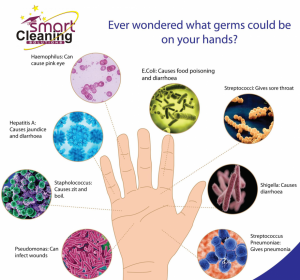Hygienic cleaning practices are important in all public areas, for example toilets, lunchrooms and gymnasiums, but they are even more important in childcare centres, aged care centres, and hospitals because the young, the old and the sick are particularly vulnerable to all sorts of infections. These three groups tend to have weaker immune systems than the rest of us, and it’s therefore important that their environments, and indeed all office and workplace environments, are kept not only clean, but extremely sanitary. Here is what you need to know about infectious diseases and how to prevent them through hygienic cleaning practices.
How infectious diseases are transmitted
Disease-causing microorganisms are usually transmitted through:
- Contact
- Droplets e.g. when someone coughs or sneezes.
- Airborne particles such as dust or pollen.
- Vectors and agents such as insects (mosquitos, fleas, ticks, and flies).
- Common material such as food or water.
Contact is the most common way through which infections are transmitted. Infections that are transmitted through contact are categorized into direct contact infections and indirect contact infections. Direct contact transmission occurs when disease-causing microorganisms are transferred to a new subject after he or she is touched by or is near an infected person. On the other hand, indirect contact transmission involves the spreading of an infection that results after the subject comes in contact with an object that is contaminated. In a childcare centre, the contaminated object can be a common toy or play equipment. In an elder care facility, office or gym the contaminated object can be any surface but common culprits are things like door handles and taps. In a hospital, the possibilities are limitless. Proper hygienic cleaning practices are the keys to limiting the transmission of infections through either direct or indirect contact.
Cleaning, sanitizing and disinfecting common objects and surfaces
In aged care facilities and hospitals, common objects and surfaces need to be cleaned, sanitized and disinfected as often as possible. Cleaning involves the removal of dirt and soil, sanitizing reduces the number of germs, and disinfection involves virtually getting rid of all germs.
Professional cleaners use spray bottles with disinfecting agents and rags to clean surfaces in care facilities and hospitals. In childcare centres, all toys, monkey bars, swings, slides etc. must be cleaned and disinfected as often as possible. In elder care facilities, surfaces and objects such as doorknobs, taps, faucets, and television remotes must also be frequently disinfected to reduce the spreading of infections.
The risk of transmission of infections through direct and indirect contact is much higher in a hospital than anywhere else. This means that commercial cleaning companies have to be even more thorough when cleaning hospitals. Cleaning agents such as bleach, ammonia, and hydrogen peroxide are used to disinfect a wide range of surfaces and objects in hospitals, including bed frames, hospital floors, and wardroom tables.
Proper handling and disposal of waste
Waste handling and disposal is an important part of hygienic cleaning. In childcare centres, wastes should not be left in the children’s play area. Young children tend put random things in their mouths, and it can be extremely dangerous if they were to get their hands on any kind of contaminated wastes. Common wastes in childcare centres include diapers, broken toys, and papers. Most childcare centres take care of children who are between 6 months and 6 years old, so some of them still need diapers. Childcare personnel should always ensure that used diapers are kept in secure bins which are out of the reach of children, as they wait for the cleaning crew to dispose of them.
In aged care centres, wastes aren’t a big issue, as long as there are enough bins placed around the facilities, and that they are frequently emptied. In hospitals, all wastes are potentially hazardous, and they should be treated as such. Medical wastes are usually handled by healthcare personnel since they are deemed too dangerous to be disposed alongside ordinary wastes. However, general hospital wastes such as cafeteria leftovers, papers, and bottles, are usually handled by commercial cleaners.
The Importance of Hygienic practices in care centres and hospitals
Hand washing is perhaps the most important hygienic practice that can reduce the transmission of infections. In childcare centres, children should be trained on how to properly wash their hands. Commercial cleaners usually wash their hands before, during and after certain cleaning tasks to prevent the spread of germs.
Protective equipment should be used in aged care centres and hospitals whenever it’s necessary. Commercial cleaners use gloves, safety goggles, gas masks, face masks, dust coats, and aprons to protect themselves as they clean and disinfect care centres and hospitals.
Childcare centres, aged care centres, and hospitals should only contract cleaners who have the means and expertise to clean, sanitise and disinfect their facilities, but even offices and gymnasiums should be sanitised as they are cleaned, particularly in flu season or when there is an outbreak or epidemic of any debilitating virus. But without doubt the health and well-being of children, the elderly, and patients must be considered in care facilities, and will depend greatly on the competence of cleaners and their diligence in sanitising while they clean. For more information about hygienic cleaning practices contact our nearest local office.
 Back to all Articles
Back to all Articles